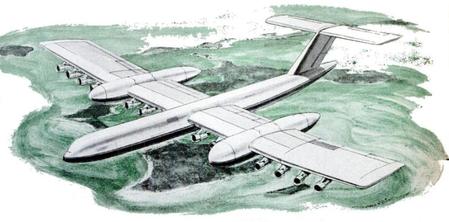Climate change means a new plan to ship Alaska's Arctic gas to market by tanker is realistic — but pipeline alternatives have a long history in the state

The Boeing RC-1, a massive air tanker designed to transport oil from Alaska’s Arctic,
never got off the drawing board. (Popular Science via Wikimedia Commons)
With climate change and the continuing decline in Arctic sea ice, a new proposal to export liquefied natural gas from Alaska in icebreaking tankers has become far more practical than anyone would have imagined even a half-century ago.....MUCH MORE
The Russian natural gas giant Novatek is already exporting LNG from the Yamal Peninsula by ship, so there is some precedent for the Alaska Qilak project now under discussion. It would operate year-round with icebreaking tankers docking 6 to 8 miles off the North Slope coast near the Point Thomson oil and gas field.
Climate change has certainly led to a change in the attitude that a gas pipeline — a project that faces many economic and political obstacles — is the only future option.
But in one sense, the discussion of non-pipeline alternatives for exporting Arctic resources is almost a replay of what happened a half-century ago.
While it’s true that several of the world’s largest oil companies were already thinking about an oil pipeline when Alaska’s giant oil strike happened in 1968, there were competing transportation ideas from the start.
In hindsight, most of the notions put forward were complicated, impractical or impossible, but unconventional ideas received at least passing attention because there was a degree of uncertainty about whether a pipeline would actually be built.
The idea of pipeline generated strong opposition at the time from environmental groups, which led visionaries, dreamers and inventors to suggest alternatives.
Oil had never been developed in a place like the North Slope of Alaska before and at first the technology to get it produced and shipped to market did not exist.
The most practical of the alternatives was to use icebreaking tankers to export oil. This idea received its grand test with the 1969 voyage of the S.S. Manhattan, a giant tanker, retrofitted to sail in ice, that became the first commercial vessel to travel the Northwest Passage.
The $40 million test was deemed a success, but the high costs were such that the tests demonstrated that icebreaking tankers would not be feasible on a large scale.
The Manhattan had to be removed from multi-year ice at one point by an icebreaker and on its second experimental trip, one of the ship’s seawater tanks was punctured by ice.
Before trans-Alaska pipeline construction began in 1974, however, there was no shortage of eccentric and outlandish ideas, ranging from dirigibles and elevated conveyors to a trans-Alaska tunnel and a monorail.
The tunnel “does not appear to present a viable alternative,” the U.S. Interior Department said in a 1972 environmental impact statement.....
Huh.
Maybe this isn't as crazy as it sounds: "Russia Is Studying the Idea Of Nuclear-Powered LNG Carrier Submarines"